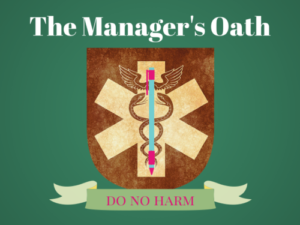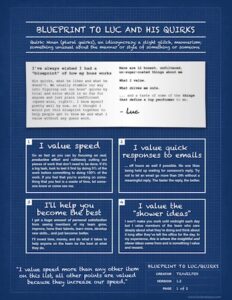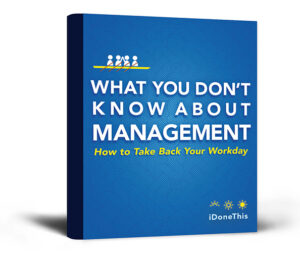Here’s an excerpt from our fresh-of-the-presses eBook, What You Don’t Know About Management: How to Take Back Your Work Day. If you like what you read, download the 50+ page eBook for free!
One of the biggest misconceptions of management is about what really drives people. In a survey of hundreds of managers by Amabile and Kramer, 95% failed to correctly identify the best motivator at work. This has huge consequences.
The most powerful motivator isn’t monetary incentives or even beneficial management techniques such as providing recognition or interpersonal support. The best motivator is simply making progress on meaningful work.
As a manager, understanding that you can have a large impact on people’s sense of progress can transform and clarify your focus on how your team gets stuff done. Your job isn’t so much to manage the tasks themselves or be “inspiring” or dictate turn-by-turn directions on what to do. Your job is to manage people and facilitate their progress by providing support, tools, resources, and feedback.
The Manager’s Oath
Understanding the power of progress is especially crucial, considering the negative impact of encountering setbacks. When Professor Amabile and Kramer analyzed nearly 12,000 employee diary entries for accounts of progress and setbacks, tracking accompanying emotional levels of happiness and frustration, they found an alarming trend.
Setbacks have more than three times as powerful an effect on motivation than the positive power of progress.
What follows should be embarrassing to managers but not surprising: the frustration, deflated sense of accomplishment, and diminished happiness that results from setbacks and obstacles often came straight from managers themselves. Stories like Lucas’s are all too common:
During our new product review meeting, the MT basically told us what our top priorities were [for] new product development. [ … ] It was discouraging that our “freedom” to choose our direction / priorities was taken away from us as a team and we were given our direction, rather than being allowed to make more decisions on our own. [Lucas, 6/30]
When you consider just how vital employee autonomy is to happiness at work, “First, do no harm” — a fundamental principle of medical ethics — should also be the manager’s mantra.
“First, do no harm” is a constant reminder to every medical professional to consider potential harms. Intervention carries risks that may ultimately cause more harm than not doing something or even doing nothing. The principle is easy to forget for doctors, because they view themselves as healers and are capable of tremendous good. But it’s essential to check the behavioral tendency that Abraham Kaplan called the law of the instrument: “Give a small boy a hammer, and he will find that everything he encounters needs pounding.”
What’s important is the health of the patient, not the dilemma between intervention and inaction. Tina Fey has a similar point when she writes in Bossypants: “In most cases being a good boss means hiring talented people and then getting out of their way.”
Getting out of the way — and making sure there aren’t other obstacles in your talented people’s way — is no small task. Doing no harm as a manager requires awareness that the people you work with are human, with lives, feelings, concerns, and depth.
In his book How Will You Measure Your Life?, Clayton Christensen describes an epiphany he had on what makes us tick. In observing Diana, a scientist in his lab, with her family at a company picnic, he started to see her in fuller perspective, with a life outside of — but connected to — work. Her mood, happiness, sense of self-worth would impact all the corners of her life, so experiencing a bad day at work — feeling “underappreciated, frustrated, and demeaned” or learning little — had larger ramifications.
Christensen imagined a sunnier possibility, where feeling engaged and having a good work day would start a positive feedback loop:
On that day, I saw her driving home with greater self-esteem — feeling that she had learned a lot, having been recognized in a positive way for achieving valuable things, and played a significant role in the success of some important initiatives for several scientists and for the company. I felt like I could see her go into her home at the end of that day with a replenished reservoir of esteem that profoundly affected her interaction with her husband and those two lovely children. And I also knew how she’d feel going into work the next day — motivated and energized.
When you take that fleshed out, three-dimensional perspective of your colleagues’ lives, the imperative behind the manager’s oath is simple but profound: we’re human beings whose mood, happiness, and self-esteem is hugely affected by what happens at work. So first, and above all, do no harm.
Understanding Who Your People Are
Having a fuller sense of the people you manage and what makes them tick can only help you do your job.
For Jason Stirman, Head of People Operations at Medium, this means putting aside work problems altogether. When he headed an engineering team at Twitter, Jason tried all sorts of stereotypical management advice like not getting too friendly with his reports and asking them what was blocking their progress — but nothing resonated. So he decided to focus on people first instead of work first by spending time with them one-on-one, taking them out to lunch and coffee.
To Jason’s surprise, he found that asking questions like “What’s going on in your life?” was more effective than “What’s blocking you at work?” to resolve many work difficulties. “Whenever problems popped up, I’d totally ignore them and pay attention to the people who had them. Suddenly all these issues were just dissolving. I swear it was like a Jedi mind trick.”
Jason also extended this technique to managing relationships within teams. If he had two people who weren’t getting along, he got them to talk about everything besides work:
[W]e got some casual conversation going, they discovered some similarities, and by the end of the hour they were talking about how to solve their issues. This was a conflict that literally kept me up at night, and as soon as there was space for them to connect as people, it was fixed. I thought, holy crap, this is a super power.
You carry your whole life around with you, no matter how much you might pretend to have a work self apart from your self-self. When you get some sense of your team’s whole selves — without prying or pressuring — you’ll be a better manager.
Use opportunities, such as one-on-one meetings, or create them like Jason did to get to know your people. As Ed Catmull, co-founder of Pixar and President of Walt Disney and Pixar Studios emphasizes: “[I]t is the focus on people — their work habits, their talents, their values — that is absolutely central to any creative venture.”
Understand how you can best help your team make headway by trying some of these techniques:
Ask about goals and motivations.
Don’t try to read minds and guess what motivates your team. Ask people about their goals. Where would they like to go in their current job? What might help them work better? What career aspirations do they have? What skills would they like to develop?
They may or may not have clear answers for you at first, but this is a meaningful opportunity for both managed and manager to spur growth, learning, and progress. So many managers don’t take the time to ask their team members where they want to head. You have the power and expertise to help them find and navigate their path.
Heart Tree Star
Heart-Tree-Star is one structured way to think through and communicate about what moves you and where you want to go.
As a manager at Microsoft who ran training and development for senior executives, Barbara Grant developed this illuminating three-part model that goes through three lines of discussion around current passion and enthusiasm, growth and skill development, and personal definitions of progress and achievement:
Heart: What do you love doing? What are you good at?
Tree: What do want to develop? How do you want to grow? Where do you want to end up in the future?
Star: How do you feel rewarded?
People are different. Their relationship to progress and goals may differ, and what works in one managerial relationship may not work in another.
Provide a Boss Blueprint
Help your team get to know you better and faster. Just as getting a glimpse into the inner workings of your team helps you manage them, providing a window into what makes you tick and your own goals is mutually beneficial.
Luc Levesque, founder of TravelPod and General Manager at TripAdvisor, even provides his employees with a concise boss blueprint that outlines his particular values, dislikes, and quirks to prime them for great performance in short order.
Addressing protracted information asymmetry at work — including revealing details about how you work and your goals — allows everyone to better able to sidestep misunderstandings and stress as well as build more effective relationships.
Find the Goldilocks Zone of Proximal Development
Help your team become superstars by challenging them enough to boost growth but not so much as to overwhelm and crush their confidence.
In the classroom, aiming to teach in something called the zone of proximal development — a level just beyond students’ current abilities — results in a higher level of performance. In Drive, Daniel Pink writes about a corresponding concept in the workplace, ascribing the standout productivity and innovation of companies like thatgamecompany and Green Cargo to their employees taking on “‘Goldilocks tasks’ — challenges that are not too hot and not too cold, neither overly difficult nor overly simple.”
Managing in that “just right” sweet spot is surprisingly uncommon, given the competitive advantage it can yield. In a survey by Lee Hecht Harrison, 62% of workers said they often feel underutilized in their jobs, while 24% said that they sometimes feel underutilized. That’s 86% of people who aren’t fully engaged and whose skills aren’t being fully harnessed. To contrast: consider how engaged employees find their peak experiences of learning and interestingness during the workweek rather than the weekend.
In order to find your team’s Goldilocks zone, you have to know them and believe not just in their current abilities but that they can grow. Again, learn about their skills, interests, and goals. Have conversations about how people feel about their work responsibilities and whether they feel underutilized or underappreciated.
Finally, back up your greater expectations. Don’t leave your team hanging when they’re dealing with new or challenging projects. Provide the resources, support, and decision-making power to meet these challenges.
3D Development
At most companies, the concept of professional advancement involves climbing a ladder — getting a more senior title and moving up in the organizational chart. But this approach takes a limited view of development. When you consider career development as multidimensional, you grow both employee and company.
At Spotify, for example, development is defined with far more breadth and possibility, which removes the emphasis from power plays and focuses more on broadening your horizons and skillset.
This involves structured learning opportunities such as attending or leading trainings, courses, workshops. Or you can move within the organization for a new position or perspective. The company’s “add-on” option allows you to work on new skills outside your job role, including training on how to mentor, write, and coach. A public speaker add-on, for example, would provide training to prepare you to speak at conferences and give talks.
People often leave their jobs, not to leave the company but to leave their manager. When you take care to listen to people, recognize their abilities, and help them grow — even if it’s to a different team within you’re company — you get to keep on a great employee.
This excerpt came from our fresh-of-the-presses eBook, What You Don’t Know About Management: How to Take Back Your Work Day. If you liked what you read, download the 50+ page eBook for free!
P.S. If you liked this article, you should subscribe to our newsletter. We’ll email you a daily blog post with actionable and unconventional advice on how to work better.
Image: RobertG NL





